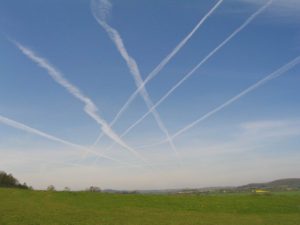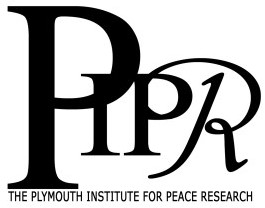Secrecy and Geoengineering as a Weapon of War
By Ian Baldwin
19 May, 2017

From NASA. Contrails or chemtrails?
This article is the third and fourth instalment by Ian Baldwin, originally published by the Vermont Independent, here https://www.vermontindependent.org/the-sorcerers-apprentices-at-play-at-the-dawn-of-the-geoengineering-age-our-geoengineering-age-part-3/ and here https://www.vermontindependent.org/secrecy-and-geoengineering-as-a-weapon-of-war-our-geoengineering-age-part-4/
During World War II “a revolution took place, one that was initiated and sustained not so much by the military as by science,” according to historian Kathleen Williams. Immediately after the war, “Military stimulation of science and technology became institutionalized” and the “Cold War ensured the military funding of science would continue…changing both academic science and the military.”[1] Sixty years ago the writer Robert Jungk noted: “In the universities, once homes of free speech throughout the world, the spirit of secrecy took possession.”[2] The Department of Defense (DoD) alone has accounted for “nearly 70 percent of all government funds directed towards research and development” of basic scientific knowledge.[3]
Science was cordoned off, in effect, inside the military-industrial complex, its findings kept under wraps. The 350-year tradition of independent, individual investigation of nature and matter gave way to the era of ‘Big Science’, meaning scientific research with big, government-funded budgets. And Big Science unequivocally included weather and climate modification, as well as other forms of geoengineering, all of which have been invariably cloaked in secrecy. But, as one physicist has noted, “secrecy always lowers the standard of environmental accountability”[4] — not to mention democratic accountability.
Two protégés of Irving Langmuir, a Nobel laureate chemist, Vincent Schaefer and Bernard Vonnegut, launched the era of modern weather modification — what Langmuir himself termed “Control of Weather” from the outset of their work together at General Electric’s research lab in Schenectady, NY — in late 1946 and early 1947 when they demonstrated that storm clouds could be made to yield snow or rain with small quantities of either dry ice (frozen CO2) or silver iodide applied to clouds.[5] Within short months the US military had hired all three scientists and launched its first weather-modification research effort, code-named Project Cirrus.
Between 1947 and 1952 the classified program conducted approximately 250 cloud and weather experiments, including a misbegotten attempt to steer a hurricane off Georgia in mid-October 1947.[6] Given the testimony of many high officials over many decades, exemplified by one Air Force general’s famous remark — “If you control the weather, you can control the world”[7] — it is unsurprising that weather and climate modification research for military ends has continued up to the present moment.
Meantime humanity’s first modern geoengineering experiment had already begun. Starting in the summer of 1945 with the Trinity Test, nuclear experiments continued vigorously well beyond the 1963 Partial Test Ban Treaty. The tests released huge amounts of radionuclides, such as strontium-90 and cesium-137, into the planet’s atmosphere and into the flesh (and bones) of living beings everywhere on Earth. Atmospheric tests did not end until 1980, and their total fallout has been estimated equivalent to 40,000 Hiroshima-size bomb detonations, releasing hundreds of megatons of environmentally destructive force into the biosphere. In aggregate, over 1,900 nuclear tests (over half by the US) have inflicted untold and publically unquantified damage to Earth’s biosphere. Estimates of the resultant incidence of cancer and cancer mortality run into the millions and even hundreds of millions.[8]
Rocket technology and nuclear technology developed in tandem in the US and USSR after WW II, fertilized by the exodus of German scientists to both countries. The US and the Soviet Union were the only nations to conduct high-altitude, upper atmosphere nuclear tests, starting in April 1958 and concluding late in 1962. Physicist James Van Allen discovered Earth’s radiation belts in Earth’s magnetic field on the basis of data gathered by the US’s first satellites, Explorer 1 and Explorer 3, in January and March 1958.
But before Van Allen could finish his scientific work, the US military made the decision to conduct what it called “the biggest scientific experiment ever undertaken.”[9]
Code-named Project Argus, the navy and air force detonated three fission bombs 100 to 325 miles over a remote sector of the South Atlantic Ocean and two hydrogen bombs 100 miles over the Pacific, near Johnston Island. Project Argus’ “research” explosions were kept classified for the next quarter century. The explosions took place in Earth’s ionosphere, defined in 1950 by the Institute of Radio Engineers as “the part of the earth’s upper atmosphere where ions and electrons are present in quantities sufficient to affect the propagation of radio waves.”[10] The Argus detonations wiped out radio communication over a large swath of the southern Atlantic Ocean for several days.[11]
Earth’s atmosphere consists of several layers, each significantly related to the other, from the lowest layer, the troposphere, where the air we breathe and the weather we experience occurs, to the stratosphere, which also holds the ozone layer, to the mesosphere, the thermosphere, and finally the exosphere, which shades into outer space. The ionosphere stretches from the mesosphere through the thermosphere and into the lower reaches of the exosphere, from 31 to 621 miles above Earth. It was this region that drew the military’s fiery curiosity: how could it be influenced, what were its secrets, and what, its powers?
Its appetite for knowledge whetted by Argus, the military exploded a much larger bomb in July 1962 as part of Project Starfish, a 1.4 megaton device — the largest ever detonated above Earth’s atmosphere. Starfish “disrupted the Van Allen belts and created an artificial magnetic belt and ‘an aurora tropicalis’ visible as far away as New Zealand, Jamaica, and Brazil,” according to James Fleming, who added, “[t]hree Soviet high-altitude explosions that year had similar effects.”[12] Rosalie Bertell, an expert on the weaponization of geophysical systems such as the ionosphere, wrote: “According to American scientists, it could take many hundreds of years for the Van Allen Belts to restabilize at their normal levels.”[13] These were humanity’s first deliberate geoengineering experiments and they occurred well over half a century ago.
The experiments were inspired by Nicholas Christofilos, a physicist who worked under Edward Teller at the Lawrence Livermore National Laboratory in order to find out if the military could create an artificial Van Allen belt to better conduct radio and other electromagnetic communication by injecting charged particles from nuclear explosions into space.[14] Argus and Starfish vindicated Christofilos’ theories. Later in 1962 Teller could boast, “We know how we can modify the ionosphere. We have already done it.”[15] Future experimentation with Earth’s protective ionosphere and magnetosphere layers was expanded from the 1960s to the 1980s using electromagnetic wave technology, and was ramped up in the 1990s with the US Navy and Air Force’s construction of the High Frequency Active Auroral Research Program’s (HAARP) ionospheric-heater “research” station in Gakona, Alaska.[16]
At the same time Argus was being wound down Project West Ford, an experiment carried out by MIT on behalf of the military in 1961 and 1963, attempted “to create a telecommunications shield in the ionosphere” by placing 350 billion “copper needles” in orbit to facilitate global radio communication.[17] This shield was placed 3,000 kilometers above Earth to form “a belt 10 km (6 miles) thick and 40 km (25 miles) wide” in order to “counteract the interference to radio communication caused by solar wind.”[18] West Ford caused a howl of protest from astronomers around the world, and was allowed to atrophy, leaving the needles suspended until they fell to Earth over ensuing years (some are estimated to still be in the ionosphere). As James Fleming wryly noted, “This is indeed geoengineering.”[19]
Captain Howard T. Orville, the first chairman of the US Advisory Committee on Weather Control established in 1953, was convinced that after Sputnik 1 and 2 the Soviets had a weapon whose potential “could even be more disastrous than nuclear warfare” [20] and became an advocate for researching the use of weather control as a weapon. Orville was quoted asserting “that the Dept. of Defense was studying ‘ways to manipulate the charges of earth and sky and so affect the weather’ by means of ‘an electronic beam to ionize or de-ionize the atmosphere over a given area.’”[21] The active concern of military planners then as now was who will “control the earth’s thermometers”[22] — “[w]ho is going to decide?”[23]
All these questions and statements were made well over half a century ago. A very long time in the cornucopian scope of modern science and engineering — and technology.
After Argus, Starfish, and West Ford, research on the ionosphere proceeded apace with construction of a worldwide network of radio frequency transmitters, and later ionospheric heaters — high frequency pump facilities that reflect radio waves from the ionosphere back to the ground — in the US, Canada, Norway, Greenland, Australia, Puerto Rico, and Peru, in partnership with what the National Academy of Sciences calls the “ionospheric modification (IM) community”[24], consisting of major research universities and institutes working in cooperation with the Pentagon. Ionospheric research also continued in the Soviet Union.
“Atmospheric modification experiments,” Dr. Bertell informs us, “can be categorized as either chemical [aerosols] or wave [electromagnetic] related.”[25] The ionosphere is an “active electrical shield protecting the planet from the constant bombardment of high-energy particles from space” and probing it with radio waves has led to the understanding that a “strong electrical coupling exists between the ionosphere and the lower atmosphere.”[26] IM community research has led to many discoveries useful to the military for global over-the-horizon communications, earth-penetrating tomography (also useful to fossil-fuel and other mining companies), surveillance, and weather or climate modification, and other purposes.[27]
After thirty years of intensive experiments, the US Air Force (USAF) could speak in 1996 of “owning the weather in 2025” and proclaim the goal of “complete dominance of global communications and counterspace [sic] control.”[28] A year after the USAF published its 5-volume Air Force 2025 report trumpeting godlike power over the atmosphere and space, Secretary of Defense William Cohen projected US military capabilities onto the nation’s then putative but non-existent enemies: “Others are engaging…in an eco-type terrorism whereby they can alter the climate, set off earthquakes, [and] volcanoes remotely through the use of electromagnetic waves….It’s real, and that’s the reason why we have to intensify our efforts” to develop these kinds of weapons [my emphasis].[29]
As if to reinforce this claim, two years later a retired French military officer, Marc Filterman, wrote in the Intelligence Newsletter that the US and Soviet Union had “mastered the know-how needed to unleash sudden climate changes (hurricanes, drought) in the 1980s.”[30] The 1980s, mission accomplished? Filterman also noted it was possible to use “weather war” weapons “to trigger atmospheric disturbances by using Extremely Low Frequency (ELF) radar.”[31]
Ever since the early days of Project Cirrus 70 years ago weather modification has been both weaponized and commercialized. Since the early 1970s over sixty countries[32] and most US western states have used weather modification technology to manipulate their weather, programs that almost certainly have had and continue to have an as yet unspecified effect on the planet’s overall climate. One region’s or one country’s drought becomes another’s flood, and one’s rain, a neighbor’s drought. The artificial weather seamlessly becomes the artificial climate. Thousands of regional weather modifications made over the past 65 years, such as the UK’s Project Cumulus (1949–1955)[33] and the US’s Project Skywater (1961–1988),[34] have collectively impacted the world’s meteorological and hydrological cycles in ways that remain largely unclarified and ignored by the UN Framework Convention on Climate Change (UNFCCC), the 1997 Kyoto Protocol, and IPCC climate modelers.
In today’s world militarily defined “security” and covert operations act as an invisible third rail that terrifies even those charged with protecting the interests of all humanity. This most certainly includes not only bureaucrats, but scientists and engineers. But if humanity cannot trust those who officially act on its behalf, whom do we trust to gain the whole truth of such surviving-the-future environmental issues as climate change?
WEATHER WEAPONS
When the US was bogged down in Indochina, it launched its highly secret weather modification program Operation Popeye to “make mud, not war” over the Ho Chi Minh Trail. This program was executed from 1967 to 1972 without the knowledge of either the governments of South Vietnam, Laos, or Thailand (from where the spray planes took off and landed, at Udon Air Base) or of the US ambassadors to those countries.[35] Not only pivotal ambassadors but top Congressional committee chairs as well as “many usually well-informed members of the Nixon administration had been kept in the dark,” according to Seymour Hersh.[36]
When syndicated columnist Jack Anderson reported on Operation Popeye in March 1971, Congress demanded disclosure in a series of hearings that lasted for two years as the military refused to divulge information. Quoting a well-informed official, Hersh explained, “This kind of thing [secret weather-modification warfare] was a bomb…and Henry [Kissinger] restricted information about it to those who had to know.”[37] Although Secretary of Defense Robert McNamara reportedly ordered a halt to the operation, according to Hersh’s sources “it went underground—into the dark”[38] and continued there until Hersh exposed it in his July 1972 New York Times reports.
Covert means covert. Few, very few of the many people needed and cleared to implement a classified military operation know the entirety of ‘the big picture’ even as it unfolds, except on a strict, hierarchical need-to-know basis. The ‘need-to-know’ system was institutionalized, in effect, by US Army engineer and Lieutenant General Leslie Groves, who oversaw the construction of the Pentagon and went on to direct the Manhattan Project to build the atomic bomb, which ended up employing 130,000 people, very, very few of whom knew what the project really was.
When Franklin D. Roosevelt died on April 12, 1944, his successor, Vice President Harry Truman, “knew only the bare fact of the Manhattan Project’s existence.” [39] As Truman reported in his memoirs, when Secretary of War Henry Stimson debriefed him shortly after FDR’s death, he did not do so fully: “…he wanted me to know about an immense project that was underway — a project looking to the development of a new explosive of almost unbelievable destructive power. That was all he felt free to say at the time, and his statement left me puzzled….but he gave me no details.” [40] The soon-to-be President of the United States could not be told the full story until later, when he formally assumed the role of Commander-in-Chief. As Vice President of the United States he lived in the dark when it came to the state’s topmost military secret, a fate he shared with practically everyone else inside the government’s top echelons.
The military and intelligence communities work according to principles of “compartmentalization” (operations, including research, are broken into segments, none of whose participants understand the details of the whole enterprise) and “need-to-know,” that together function as “containment,” so that the overall project or program’s intent is masked or opaque to all but a very few decision makers.[41] Ambassadors and powerful senators are among those high up in the hierarchy who may be foreclosed. As former insider Daniel Ellsberg, who had many security clearances, admitted: “Once I was inside the government, my awareness of how easily and pervasively Congress, the public, and journalists were fooled and misled contributed to a lack of respect” for them.[42]
The anthropologist Hugh Gusterson observed: “Secrecy is a means by which power constructs itself as power, and the knowledge of secrets is a perquisite of power.”[43] Pervasive secrecy and democracy cannot coexist. The experiment that began with the inauguration of George Washington as the first US president in 1789 is or will be (or has been) undone when secrecy reaches a threshold beyond which the mores of empire eclipse those of a democratic republic.
In a report submitted to the Congress after the Vietnam War, the highly influential UCLA-based geoscientist Gordon J. F. MacDonald argued that the key lesson of that war was not the failure of Operation Popeye to alter its outcome but that “one can conduct covert operations using a new technology in a democracy without the knowledge of the people” [emphasis added].[44] This lesson has been bred into the bones of the military establishments of the Western democracies ever since Vietnam.
In reaction to the massive use of weather modification, defoliants, and herbicides such as Agent Orange, as well as other toxic aerosols — directly killing one to 3.5 million Vietnamese, maiming tens of thousands still being born with birth defects, and disrupting the ecology of 40 percent of their land, “reducing dense jungles and mangrove forests to barren wastelands”[45]— the world community created the 1978 Convention on the Prohibition of Military or Any Other Hostile Use of Environmental Modification Techniques (ENMOD). Rattled by the uproar caused by Daniel Ellsberg’s release of the Pentagon Papers to the New York Times and the subsequent US Senate hearings led by Senator Frank Church, the US ratified ENMOD in 1979.
However, rather than halting weather and other environmental modification programs, the treaty had the effect of causing them to be more rigorously disguised as “research” or sequestered inside the unscrutinized budgets of “‘black’ or secret operations,”[46] and thus outside either the purview of ENMOD or US citizens and their institutions of representation. After ENMOD the military-science-industrial research complex went further underground.[47] Two decades later, 9-11 drove it yet deeper underground with the advent of a new, corrosive ethos of perpetual war[48] that again made the words ‘national security’ a supreme state prerogative, an unchallengeable barrier to independent inquiry, and furthered the steady retreat of the mainstream press’s willingness to confront power.
Gordon MacDonald, who served on the National Science Foundation’s Advisory Panel for Weather Modification from 1964 to 1967, had warned that ENMOD or environmental warfare “could damage an adversary without revealing its [the aggressor’s] intent” and that “applying such techniques [of war] under cover of nature’s irregularities presents a disquieting prospect.”[49] MacDonald added that a secretly waged weather war “need never be declared or even known by the affected populations. It could go on for years with only the country’s [aggressor’s] security forces involved being aware of it” (emphasis added), as the complex randomness of the weather makes accusations of aggression plausibly deniable.[50]
Geoengineering as a species of environmental modification hides inside the military-science-industrial complex, a symbol of power fully endowed with the charisma secrecy bestows.
Ian Baldwin is a life-long environmentalist and co-founder and Publisher Emeritus of Chelsea Green. After working for several national environmental organizations in the 1970s, he co-founded the EF Schumacher Society (US) before launching Chelsea Green in 1984 with his wife Margo Baldwin. In 2005, he and Rob Williams co-founded Vermont Commons: Voices of Independence to explore the possibilities of rescaled living in a future Vermont republic.
[1] Kathleen B Williams, “The Military’s Role in Stimulating Science and Technology: The Turning Point,” Foreign Policy Research Institute, May 2010. Accessed July 30, 2015. See also: Fleming, Fixing the Sky, 167-169.
[2] Robert Jungk, Brighter than a Thousand Suns: A Personal History of the Atomic Scientists, translated by James Clough (San Diego, CA: Harcourt, 1958), 255.
[3] K B Williams, Op. Cit. See also Melman, Permanent War Economy, 20-21, 30 and Gusterson, Nuclear Rites, 43.
[4] Richard Williams, “Atmospheric Threat,” Comment, Physics and Society, 27, No. 2 (1988), 16.
[5] Fleming, Fixing the Sky, 143-149.
[6] Ibid., 150-152.
[7] Earl Lane, “Author and Historian Questions Whether ‘Fixing the Sky’ Can Address Climate Change,” American Association for the Advancement of Science, October 22, 2010. Accessed July 30, 2015.
[8] Eduardo Goncalves, “The Secret Nuclear War,” The Ecologist, 31, 3, April 2001. Accessed July 29, 2015.
[9] Rosalie Bertell, Planet Earth, the Latest Weapon of War: A Critical Study into the Military and the Environment (London: The Women’s Press, 2000), 64. See also Fleming, Fixing the Sky, 209-210.
[10] Encyclopædia Britannica Online, s. v. “ionosphere and magnetosphere.” Accessed July 06, 2015.
[11] Rosalie Bertell, “Background on the HAARP Project,” Global Policy Forum, November 5, 1996. Accessed June 15, 2015.
[12] Fleming, Fixing the Sky, 210. See also: Bertell, Planet Earth, 68-72.
[13] Bertell, Op. Cit., 71.
[14] “Operation Argus: 1958–South Atlantic,” Nuclear Weapon Archive. Accessed July 28, 2015.
[15] Jacob Darwin Hamblin, Arming Mother Nature: The Birth of Catastrophic Environmentalism (Oxford: Oxford University Press, 2013), 12.
[16] Dr. Nick Begich and Jeane Manning, Angels Don’t Play This HAARP: Advances in Telsa Technology (Anchorage: Earthpulse Press, 1995, 2002).
[17] Bertell, Planet Earth, 67.
[18] Ibid.
[19] Fleming, Fixing the Sky, 212.
[20] Ibid.,176. See also “Case Study 2: Weather Modification: The Evolution of an R&D Program into a Military Operation,” United States Military, undated, 4, Accessed May 13, 2015.
[21] Lowell Ponte, The Cooling (Englewood Cliffs, NJ: Prentice-Hall Inc., 1976), 169.
[22] Matt Novak, “Weather Control as a Cold War Weapon,” Smithsonian, December 5, 2011. Accessed May 28, 2015.
[23] Charles J Hanley, “Tweaking the Climate to Save it: Who Decides?” Associated Press, April 3, 2011, accessed July 5, 2015.
[24] National Research Council, Opportunities for High-Power, High-Frequency Transmitters to Advance Ionospheric/Thermospheric Research: Report of a Workshop (Washington, DC: The National Academies Press, 2014).
[25] Bertell, Planet Earth, 114.
[26] Begich and Manning, Angels, 71.
[27] Bertell, Op. Cit. See also T J Coles, “Weather weapons: the dark world of environmental warfare,” Lobster Magazine, Issue 62, Winter 2011. Accessed on August 02, 2015.
[28] Col. Tamzy J House et al, “Weather as a Force Multiplier: Owning the Weather in 2025,” research paper presented to Air Force 2025 by the Department of Defense, June 17, 1996, and published as Chapter 15 in Vol. 3 of the USAF Air Force 2025 (5 volumes). Accessed August 05, 2015.
[29] William Cohen, “Terrorism, Weapons of Mass Destruction, and U.S. Strategy,” address by Secretary Cohen at Sam Nunn Policy Forum, University of Georgia, Athens, Georgia, April 28, 1997. Accessed July 15, 2015.
[30] Michel Chossudovsky, “Washington’s New World Order Weapons Have the Ability to Trigger Climate Change,” Centre for Research on Globalization, January 4, 2002. Accessed July 20, 2015.
[31] Ibid.
[32] E B Weiss, “International Responses to Weather Modification,” International Organization, 29 (3), Summer 1975, 805–836, as cited in “Case Study 2,” 29.
[33] John Vidal and Helen Weinstein, “RAF rainmakers ‘caused 1952 flood’,” The Guardian, August 30, 2001. Accessed August 25, 2015.
[34] Jedediah S Rogers, “Project Skywater,” Bureau of Reclamation, 2009. Reformatted and edited by Adrew H Gahan, July 2013. Accessed May 29, 2015.
[35] Fleming, Fixing the Sky, 180.
[36] Seymour Hersh, “Rainmaking Is Used As Weapon by U.S.,” The New York Times, July 3, 1972.
[37] Seymour Hersh, “Weather As a Weapon Of War,” The New York Times, July 9, 1972.
[38] Ibid.
[39] Richard Rhodes, The Making of the Atomic Bomb (New York: Simon & Schuster, 1986), 614.
[40] As quoted in Richard Rhodes, Op. Cit., 617.
[41] Daniel Ellsberg, Secrets: A Memoir of Vietnam and the Pentagon Papers (New York: Viking Penguin, 2002). See also Begich and Manning, Angels, 84 and Gusterson, Nuclear Rites, 75-92.
[42] Ellsberg, Secrets, 44.
[43] Gusterson, Nuclear Rites, 87.
[44] Fleming, Fixing the Sky, 182.
[45] Bertell, Planet Earth, 158. See also: Dana Visalli, “The Greatest Danger in the World Today,” Information Clearing House, May 1, 2015. Accessed May 28, 2015,
[46] Pauline Cantwell, talk presented at the United Nations DPI/NGO Conference, September 5, 2007. Accessed May 20, 2015.
[47] Bertell, Planet Earth, 45-46, 114. See also Fleming, Fixing the Sky, 184-186.
[48] James Risen, Pay Any Price: Greed, Power, and Endless War (Boston: Houghton Mifflin Harcourt, 2014).
[49] Gordon J F MacDonald, “How to Wreck the Environment,” in Unless Peace Comes: A Scientific Forecast of New Weapons, ed. Nigel Calder (New York: The Viking Press, 1968), 188.
[50] Ibid., 203.





